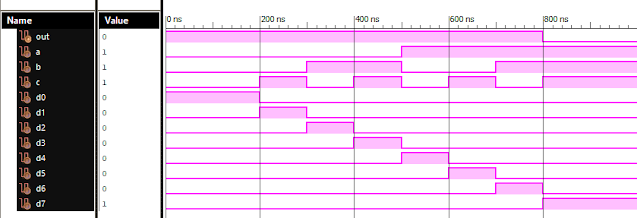Latest Post
VLSI - Verilog Programming
- Get link
- X
- Other Apps
Three main programming techniques in VLSI Programming are :
1. Gate Level Modelling
2. Data-flow Modelling
3. Behavioral Modelling
Solutions to exercises of the book, click on the below given link:
-----------------------------------------------------------------
Here you can find Verilog programs of standard Logic Gates, Converter Circuits, Multiplexers, Encoders, Decoders, etc.
Verilog Gate Level Modelling / Structural Modelling:
Verilog Program for AND Gate (Structural / Gate Level Modelling)
Verilog Program for OR Gate (Structural / Gate Level Modelling)
Verilog Program for NOT Gate (Structural / Gate Level Modelling)
Verilog Program for NAND Gate (Structural / Gate Level Modelling)
Verilog Program for NOR Gate (Structural / Gate Level Modelling)
Verilog Program for XOR Gate (Structural / Gate Level Modelling)
Verilog Program for XNOR Gate (Structural / Gate Level Modelling)
Verilog Program for Half Adder (Structural / Gate Level Modelling)
Verilog Program for Full Adder (Structural / Gate Level Modelling)
Verilog Program for Half Subtractor (Structural / Gate Level Modelling)
Verilog Program for Full Subtractor (Structural / Gate Level Modelling)
Verilog Program for 4-1 MUX (Structural / Gate Level Modelling)
Verilog Program for Binary to Gray Converter (Structural / Gate Level Modelling)
Verilog Program for 2-4 Decoder (Structural / Gate Level Modelling)
Verilog Program for 3-8 Decoder (Structural / Gate Level Modelling)
Verilog Program for 4-2 Encoder (Structural / Gate Level Modelling)
Verilog Dataflow Modelling:
Dataflow Modelling Verilog Codes for Logic Gates:
Logic Gates
Dataflow Modelling Verilog Codes for Adder and Subtractor:
Dataflow Modelling Verilog Codes for Multiplexer and Demultiplexer:
Dataflow Modelling Verilog Codes for Logic Converter:
Gray Code to Binary Code Converter
Binary Code to Gray Code Converter
Dataflow Modelling Verilog Codes for Logic Decoders and Encoders:
Dataflow Modelling Verilog Codes for Logic Comparators:
Behavioral Modelling Verilog Codes:
Behavioral Modelling Verilog Codes for Logic Gates:
Behavioral Modelling Verilog Codes for Adder and Subtractor:
Behavioral Modelling Verilog Codes for Logic Multiplexer and Demultiplexer:
Behavioral Modelling Verilog Codes for Logic Encoders and Decoders:
Behavioral Modelling Verilog Codes for Comparators:
Behavioral Modelling Verilog Codes for Converters:
Behavioral Modelling Verilog Codes for Flip-Flops:
SR Flip Flop
Behavioral Modelling Verilog Codes for Counters:
Verilog Codes for User Defined Premitives:
More Coming Soon...
- Get link
- X
- Other Apps
Popular posts from this blog
VLSI: 1-4 DEMUX (Demultiplexer) Dataflow Modelling with Testbench
Verilog Code for 1-4 DEMUX Dataflow Modelling module demux_1_to_4( input d, input s0, input s1, output y0, output y1, output y2, output y3 ); assign s1n = ~ s1; assign s0n = ~ s0; assign y0 = d& s0n & s1n; assign y1 = d & s0 & s1n; assign y2 = d & s0n & s1; assign y3 = d & s0 & s1; endmodule //Testbench code for 1-4 DEMUX Dataflow Modelling initial begin // Initialize Inputs ...
Verilog: 8 to 1 Multiplexer (8-1 MUX) Dataflow Modelling with Testbench Code
Verilog Code for 8 to 1 Multiplexer Dataflow Modelling module mux_8to1( input a, input b, input c, input D0, input D1, input D2, input D3, input D4, input D5, input D6, input D7, output out, ); module m81( output out, input D0, D1, D2, D3, D4, D5, D6, D7, S0, S1, S2); assign S1bar=~S1; assign S0bar=~S0; assign S2bar=~S2; assign out = (D0 & S2bar & S1bar & S0bar) | (D1 & S2bar & S1bar & S0) | (D2 & S2bar & S1 & S0bar) + (D3 & S2bar & S1 & S0) + (D4 & S2 & S1bar & S0bar) + (D5 & S2 & S1bar & S0) + (D6 & S2 & S1 & S0bar) + (D7 & S2 & S1 & S0); endmodule //Testbench code for 8-1 MUX Dataflow Modelling initial begin // Initialize Inputs a= 0;b = 0;c = 0;D0 = 1;D1 = 0;D2 = 0;D3 = 0;D4 = 0;D5 = 0;D6 = 0;D7 = 0; // Wait 100 ns for global reset to finish #100; // Add stimulus here #100; a = 0;b = 0;c = 1;d0 = ...
VLSI: 4-1 MUX Dataflow Modelling with Testbench
Verilog Code for 4-1 MUX Dataflow Modelling module m41(out, i0, i1, i2, i3, s0, s1); output out; input i0, i1, i2, i3, s0, s1; assign y0 = (i0 & (~s0) & (~s1)); assign y1 = (i1 & (~s0) & s1); assign y2 = (i2 & s0 & (~s1)); assign y3 = (i3 & s0 & s1); assign out = (y0 | y1 | y2 | y3); endmodule //Testbench code for 4-1 MUX Dataflow Modelling initial begin // Initialize Inputs a = 1;b = 0;c = 0;d = 0;s0 = 0;s1 = 0; ...
Full Subtractor Verilog Code in Structural/Gate Level Modelling with Testbench
Verilog Code for Full Subtractor Structural/Gate Level Modelling module full_sub(borrow,diff,a,b,c); output borrow,diff; input a,b,c; wire w1,w4,w5,w6; xor (diff,a,b,c); not n1(w1,a); and a1(w4,w1,b); and a2(w5,w1,c); and a3(w6,b,c); or o1(borrow,w4,w5,w6); endmodule //Testbench code for Full Subtractor Structural/Gate Level Modelling initial begin // Initialize Inputs a = 0; b = 0; c = 0; // Wait 100 ns for global reset to finish #100; // Add stimulus here #100; a = 0;b = 0;c = 1; #100; a = 0;b = 1;c = 0; #100; a = 0;b = 1;c = 1; #100; a = 1;b = 0;c = 0; #100; a = 1;b = 0;c = 1; #100; a = 1;b = 1;c = 0; #100; a = 1;b = 1;c = 1; end Output: RTL Schematic: Full Subtractor Verilog Other Verilog Programs: Go to Index of Verilog Programming
VLSI: 8-3 Encoder Dataflow Modelling with Testbench
Verilog Code for 8-3 Encoder Dataflow Modelling module encoder_8_to_3( input d0, input d1, input d2, input d3, input d4, input d5, input d6, input d7, output q0, output q1, output q2 ); assign q0 = ( d1 | d3 | d5 | d7 ); assign q1 = ( d2 | d3 | d6 | d7 ); assign q2 = ( d4 | d6 | d5 | d7 ); endmodule //Testbench code for 8-3 Encoder Dataflow Modelling initial begin ...





Comments
Post a Comment